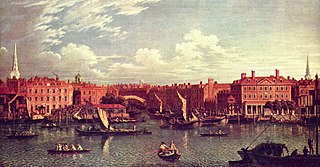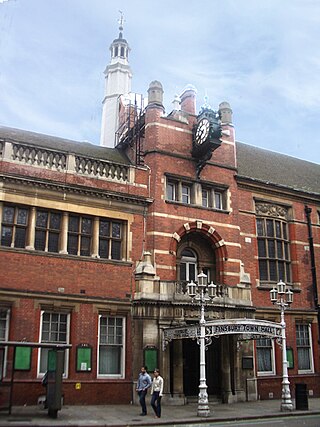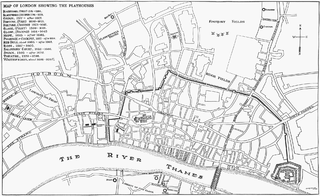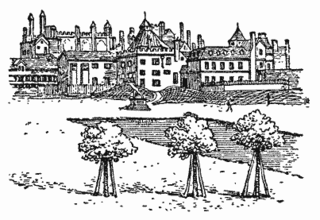
The London Borough of Islington is a London borough which forms part of Inner London, England. Islington has an estimated population of 215,667. It was formed in 1965, under the London Government Act 1963, by the amalgamation of the metropolitan boroughs of Islington and Finsbury.

Clerkenwell is an area of central London, England.

The River Fleet is the largest of London's subterranean rivers, all of which today contain foul water for treatment. It has been used as a culverted sewer since the development of Joseph Bazalgette's London sewer system in the mid-19th century with the water being treated at Beckton Sewage Treatment Works. Its headwaters are two streams on Hampstead Heath, each of which was dammed into a series of ponds—the Hampstead Ponds and the Highgate Ponds—in the 18th century. At the southern edge of Hampstead Heath these descend underground as sewers and join in Camden Town. The waters flow 4 miles (6 km) from the ponds.

Old Street is a 1-mile (1.6 km) street in inner north-east Central London, England that runs west to east from Goswell Road in Clerkenwell, in the London Borough of Islington, via St Luke's and Old Street Roundabout, to the crossroads where it meets Shoreditch High Street (south), Kingsland Road (north) and Hackney Road (east) in Shoreditch in the London Borough of Hackney.

The Metropolitan Borough of Finsbury was a metropolitan borough within the County of London from 1900 to 1965, when it was amalgamated with the Metropolitan Borough of Islington to form the London Borough of Islington.
Princes Street is one of the major thoroughfares in central Edinburgh, Scotland and the main shopping street in the capital. It is the southernmost street of Edinburgh's New Town, stretching around 1.2 km from Lothian Road in the west, to Leith Street in the east. The street has few buildings on the south side and looks over Princes Street Gardens allowing panoramic views of the Old Town, Edinburgh Castle, as well as the valley between. Most of the street is limited to trams, buses and taxis with only the east end open to all traffic.

The Red Bull Theatre was an inn-yard conversion erected in Clerkenwell, London, operating in the 17th century. For more than forty years, it entertained audiences drawn primarily from the City and its suburbs, developing a reputation over the years for rowdiness. After Parliament closed the theatres in 1642, it continued to host illegal performances intermittently, and when the theatres reopened after the Restoration, it became a legitimate venue again. There is a myth that it burned down in the Great Fire of London but the direct reason for its end is unclear.
The EC postcode area, also known as the London EC postal area, is a group of postcode districts in central London, England. It includes almost all of the City of London and parts of the London boroughs of Islington, Camden, Hackney, Tower Hamlets and Westminster. The area covered is of very high density development. Deliveries for the EC postcode area are made from Mount Pleasant Mail Centre.

Goswell Road, in Central London, is an end part of the A1. The southern part ends with one block, on the east side, in City of London; the rest is in the London Borough of Islington, the north end being Angel. It crosses Old Street/Clerkenwell Road. In the north it splits Clerkenwell from Finsbury; the south was sometimes used as a demarcator but all but the southern corporate/legal/financial end in the modern era forms the heart of the highly developed mixed-use district Barbican.

Hicks Hall, or Hickes' Hall, was a courthouse at the southern end of St John Street, Clerkenwell, London. It opened in 1612, and was closed and demolished in 1782. It was the first purpose-built sessions house for justices of the peace of the county of Middlesex, and became the main court of petty sessions and arraignment for more serious offences, including cases involving plots, attacks and minor transgressions against the state.

St Sepulchre was an ancient parish which had its southern part within the boundaries of the City of London and its northern part outside. Its former area is now within the contemporary neighbourhoods of Smithfield, Farringdon and Clerkenwell.

Coade stone or Lithodipyra or Lithodipra is stoneware that was often described as an artificial stone in the late 18th and early 19th centuries. It was used for moulding neoclassical statues, architectural decorations and garden ornaments of the highest quality that remain virtually weatherproof today.

The Cockpit was a theatre in London, operating from 1616 to around 1665. It was the first theatre to be located near Drury Lane. After damage in 1617, it was named The Phoenix.

The Cockpit-in-Court was an early theatre in London, located at the Palace of Whitehall, next to St. James's Park, now the site of 70 Whitehall, in Westminster.

The Salisbury Court Theatre was a theatre in 17th-century London. It was in the neighbourhood of Salisbury Court, which was formerly the London residence of the Bishops of Salisbury. Salisbury Court was acquired by Richard Sackville in 1564 during the last seven years of his life when he was Chancellor of the Exchequer under Queen Elizabeth; when Thomas Sackville was created Earl of Dorset in 1604, the building was renamed Dorset House.
Hockley-in-the-Hole was an area of Clerkenwell Green in central London where bull-baiting, bear-baiting and similar activities occurred in the 17th and 18th centuries. The Beargarden was located at Hockley-in-the-Hole where the Coach pub is today, at the junction of Back Hill and Ray Street, north of the junction of Clerkenwell Road and Farringdon Road.

Mare Street is a street in the London Borough of Hackney. It has existed since the 15th century, when it was one of the first roads at the centre of the parish. It was then known as Merestret. The word mere was either the Old English mǣre meaning a boundary — referring to the boundary with the parish of Stepney — or mere, a large pond which was fed by Hackney Brook.

Turnmill Street is a street in Clerkenwell, London. It runs north–south from Clerkenwell Road in the north, to Cowcross Street in the south. One of the oldest streets in London, it has been variously known as Turnmill and Turnbull Street over its history. During the Elizabethan era, under the name Turnbull Street it became "the most disreputable street in London", notorious as a centre of crime and prostitution.

The Bull and Mouth Inn was a coaching inn in the City of London that dated from before the Great Fire of London in 1666. It was located between Bull and Mouth Street in the north and Angel Street in the south. It was once an important arrival and departure point for coaches from all over Britain, but particularly for the north of England and Scotland. It became the Queen's Hotel in 1830 but was demolished in 1887 or 1888 when new post office buildings were built in St Martin's Le Grand.
















